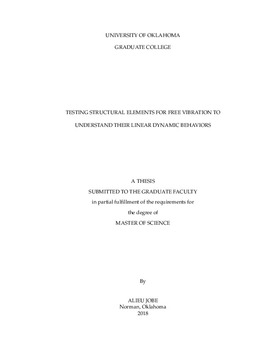| dc.description.abstract | Dynamic forces such as strong seismic, wind, and impact loads can cause severe deterioration of structural elements in residential, commercial and other structural systems. In the field of structural health monitoring (SHM), inherent dynamic attributes of structures are often utilized to assess structural integrity. In modeling and testing, a free vibration refers to a vibration when a sustained excitation force is not required but a non-zero initial displacement and/or velocity is. A free vibration is useful because it reveals inherent dynamic characteristics of the structure itself, which include but are not limited to modal frequencies and mode shapes in linear analysis, as commonly used, and backbones in nonlinear analysis, which are gaining attention.
This study consisted of experimental investigation and data analysis conducted on some of the most common structural elements subjected to free vibration. The scope of the experimental work was extensive spanning two years and involving a real-world prestressed concrete bridge girder tested after four decades of service, a half-scale reinforced masonry wall, a full-scale timber shear wall, and a number of scaled timber connection specimens. All tests were conducted using a modal hammer. A large amount of quality data was collected for future studies using nonlinear techniques (e.g., backbones). The data analysis in this study, however, had a reduced scope focused on only two test specimens; the bridge girder and masonry wall. The goal was to achieve a good understanding of modeling using collected data, and develop a detailed and general linear dynamics data processing and result analysis procedure - paired with modular code - for the two specimens considered in-depth and other test specimens to follow.
Such an in-depth study for a seemingly straightforward free vibration test is motivated as follows: First, a modal hammer test in fact generates both forced and free vibration; using only the free vibration portion of the data is the most proper for exacting fundamental frequency. Next, all models have their applicable range. The A real-world specimen has more than one degree of freedom. Thus, other degrees-of-freedom will be checked using the experimental data to better understand what the extracted fundamental frequency represents for each specimen. The procedure and code developed during this research are demonstrated using the real-world bridge girder and half-scale masonry wall, the two specimens with significance for SHM. | en_US |
